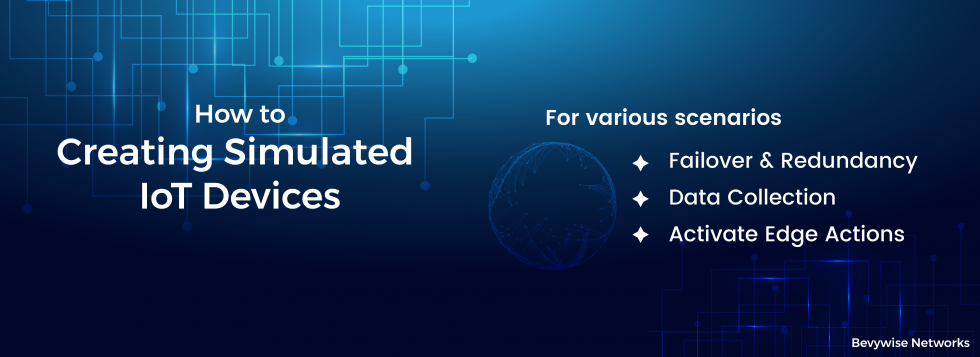How to create simulated IoT Device?
by Ranjith Kumar DSM | Jul 12, 2017 | iot simulator, MQTT simulation | 0 comments

Bevywise IoT Simulator is a Free, highly scalable IoT Device Simulation suite that helps you simulate various scenarios needed for developing , testing and demonstrating realtime devices and managers. You can create a simulated IoT device simply from the user interface.
There are three major requirement under which the IoT Devices M2M communication can be grouped. They are:
- — Failover & Redundancy
- — Data Collection
- — Activate Edge Actions
This article explains how we can simulate IoT Devices. The simulated IoT Device can be used along with your real devices to act as one of the missing edge devices to have a complete test environment.
IOT Device Failover & Redundancy:
Any redundancy set up needs a master and standby device. We need to propagate the IoT failure of the master to the standby device. In our scenario, we connect the master and the standby device to the broker and the standby will subscribe to the status of the master device. The broker will notify the standby device when the master goes off for the standby device to take over. This scenario can be done using two simulated IoT device.
Take an example of the Diesel Generator of a large facility. It has a master and a standby generator. The master should register a WILL Topic and message to the broker and the standby generator should subscribe to the will topic of the master. When the master Diesel generator goes down, the broker will send the message to the interested clients.
You should configure a WILL Message with a topic /facility/dg_master_status with a Open DOWN which the broker publishes on disconnect of the device.
The DG-Standby should listen to the master status and do the necessary action. This requires two kinds of action.
- — Getting the Standby up and serve the need.
- — Sending the status to the Facility manager.
The DB Standby should be configured with a subscription for the Will topic of the master /facility/dg_master_status . So whenever the DG Master is down, the DG Standby will receive a message to take action. The following video helps you with the subscription to the necessary topics.
As this is the simulated Standby The standby DG we need to also publish a messages saying that the Slave DB is UP. So when the DG Slave receives a messages of master down, it publishes a slave status active. You can achieve this via the Request Response..
Request Topic & Message – DG_Standby :/facility/dg_master_status : Down
Response Topic & Messages – /facility/dg_slave_status : Active
The following video helps you with the behaviour simulation.
Data Collection:
Every decision taken today is powered by the data. The perfect decision making needs a lot of time series data. This mandates the need for collecting data from the edge device for every second or minute based on the device.
You can configure IoT Simulator to send data continuously to the broker and the interested server every second. In Healthcare , health data is necessary to record and send every second. Let us now simulate a device that records and sends data to the manager application. We need to send a messages every few seconds for the monitors.
Every 5 second is the most possible time interval for sending data. You can configure time in a very much of a flexible pattern to send every minute or every hour or particular minute of every hour or particular second of every minute and more.
IoT Device Actions:
Sensors mostly work on the data collection. But You need to process these data and to take the necessary action. The IoT Platform gives you the flexibility to aggregate and process the data. The inference from this data can trigger messages to the edge devices which can trigger actions at the edge.
We can take water level sensor and a water pump switch as an example of how we can sense data as well as take actions. In this scenario, the water pump needs to be started when the level is low and needs to be stopped when the water level is high. The water pump will also publish the current status once the the status changes. We can configure this scenario using the Event publishing and behaviour simulator as shown in the previous videos.
Hope this article helped you simulate your own IoT Device using the IoT Simulator. Do feel free to write to us if you need any assistance with your device. We do have a few advanced options like Intercepting and customisation of messages and API Control which we will talk in detail in our next article.
Download the IoT Simulator for FREE now to create your own simulated IOT device that mimics your real devices.
Do feel free to write to us your feedback and queries using the contact page.
Submit a Comment
Please take a moment to fill this form
